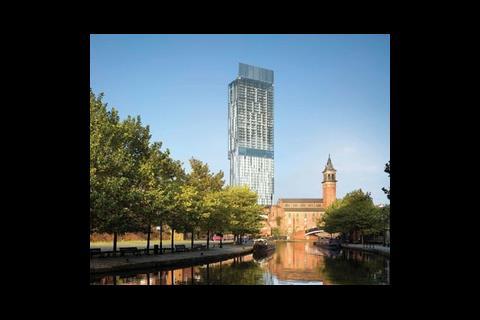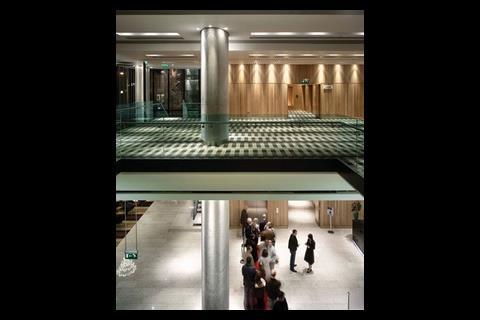The new Beetham Tower has a simple elegance. But building the requirement for natural ventilation and a single-stair fire safety solution into Manchester’s tallest residential building had its complications
A decade ago they couldn’t wait to pull them down, but now it seems the British are embracing the idea of high-rise living as developers across the UK join the race to create the tallest tower blocks.
Not that they bear much resemblance to their post-war counterparts. The latest generation of luxury glass and steel high-rises are as much about creating icons for the cities they’re home to as they are about mass accommodation.
Currently, Manchester’s Beetham Tower – or 301 Deansgate as it’s officially known – has the lead. Engineering challenges don’t come much taller. At 171.5 m not only is it the city’s tallest building by far, it’s also outstrips all other residential buildings in western Europe – so far. On a clear day from the top of the £150 million high-rise you can see to the Pennines, Liverpool and the Welsh mountains. It’s an outlook the scheme’s architect, and advocate of high-rise living, Ian Simpson will get to enjoy at his leisure, when later this year he moves into his two-storey penthouse suite on the 47th floor.
Below the stunning penthouse are a further 24 floors of one- and two-bedroom residential apartments beneath which, at the point where the south-facing elevation steps in, the building morphs into the 285-bed Hilton hotel. It was this mix of hotel and private residential, combined with the building’s elegant design – its 7:1 slenderness ratio is on the edge of what is structurally possible – that provided the engineering team with one of its biggest challenges.
WSP Fire Engineering’s technical director Jason Oldham reveals it’s what drove them to come up with an innovative fire and escape strategy that broke with traditional codes. A conventional two-stair solution through the building’s pair of main cores was originally considered. But with such a small footprint this took a large bite out of the floor area.
“Recognising we had two different uses that you’re traditionally not meant to mix, we approached �ǿմ�ý Control and the Fire Officer early on to say we were thinking of looking at a single-stair solution for the private residential apartments,” Oldham says. It relies on a transfer corridor at the 23rd floor where the hotel ends and the residential floors begin. “It basically takes the form of an h-shape, with a single escape stair for the residential apartments that reverts to two stairs for the hotel, which they both then share,” explains Oldham.
A risk assessment study was carried out to gauge the design, and measures were put in place to separate the staircase where it reaches the lower levels from the back of house areas of the hotel to prevent day-to-day use by staff. On the upper levels with the single stair there are extended travel distances, so a full mechanical smoke flushing system is installed. A supply fan in the 24th floor plant room delivers air via motorised louvres on to the relevant fire floor; this pushes smoke out through a builders’ work shaft to the roof. The design was validated using CFD and by test at the commissioning stage.
Along with the fully sprinklered hotel, the risk assessment also dictated sprinklers for one of the apartments on each floor. These were considered vulnerable because of their position in a dead end quite close to the entrance of a staircase and, because they are studios, they lack the normal lobby of the larger apartments.
This, again, breaks new ground, using a low-pressure mist system more common to ships than buildings. “You only need about a quarter of the tank storage,” says Oldham. “The other benefit was aesthetics. This is wall-mounted and only the size of a cigarette packet.”
It’s a neat solution that was also cost-neutral. The single device contains two sprinkler heads, enough to cover the 6 m wide space, which produces both fine water particles as well as traditional water droplets that get sucked into the fire. “Although there were marine standards for it which were extremely onerous, there were no British Standards for using it in buildings so, again, we had to get �ǿմ�ý Control and the Fire Officer to approve it.”
The services strategy, too, has provided a steep learning curve on how best to tune things to satisfy the regulations. Take the ventilation. With apartments so high up, it wasn’t entirely known how the natural ventilation strategy would cope. “Because we had so much glass – the façade is 70% glazed – we carried out dynamic thermal modelling on one floor of apartments to see how hot they would get,” says Simon Hocknell, technical director of WSP �ǿմ�ýs. “They do get reasonably warm in the summer, but the south-facing ones aren’t half as bad as you’d expect because of the winter garden and the ventilation provided.”
This garden is, effectively, a glass-enclosed balcony accessed via patio doors through the main unitised double-glazed cladding. Openable louvres then allow fresh air into the enclosed space. The gardens do a number of things, says Hocknell. “They act like a thermal buffer to the building, and each balcony floor provides solar shading for the apartments beneath.”
They also help with ventilation. The louvres give much more than the 5% free area needed for ventilation under Part F and they provide control to the fresh air that passes through and into the apartment. Since Beetham, Hocknell has used the concept on a number of high-rise schemes. “It’s one of the lessons we’ve learned, particularly for meeting 2006 Part L. It’s also a unique selling point for the agent as, unlike balconies, winter gardens count as net lettable.”
The modelling of the north-facing apartments was more surprising. They were difficult to vent, says Hocknell, so working with Ian Simpson Architects they came up with another plan. The solution is vent panels, which basically take the form of an openable solid door in the façade with a perforated metal sheet that acts as a rain screen and prevents anything being thrown out. These are used in the bedrooms and living areas, providing single-sided ventilation, or cross ventilation for the corner apartments.
“With the wind speeds high up, the risk of the apartments overheating is low,” says Alex Kniveton, associate at WSP �ǿմ�ýs. The other issue that had to be tackled was the 5% openable area for ventilation outlined in Part F. “With the wind speeds occurring at height it seemed nonsensical to go for 5% and so we had discussions with what was then the ODPM to look at reducing this figure. Once we could show that we could get the required ventilation rate through a lower area, they approved it,” he adds.
Although it was designed for the 2002 Part L, Hocknell is reasonably sure that the design would pass the 2006 requirements. Part of his confidence comes from the façade treatment and part from the incorporation of a 350 kW gas-fired CHP plant. “This was one of the advantages we could take from it being a mixed-use development,” he says.
The plant is sized to meet the base electrical load of the hotel and also acts as the lead boiler, feeding into a common header that supplies all the hot water needs for the hotel and the residential apartments. Backing this up are four further gas-fired boilers, two serving the hotel and two for the residential floors. “It’s because [the developer] was happy to manage the whole lot that it worked,” says Kniveton. The CHP also doubles as the alternative supply for the life safety systems, taking the place of a generator.
With mixed-use developments the residential usually sits on top, posing the problem of how to get the drainage together before it goes through the floors below. The solution was a plant level slotted in between the residential and hotel floors. Here, the drainage is collected together before passing down through two wet risers common to the hotel and residential floors. “It makes sense to have a plant floor as the floors below are usually more heavily serviced, with room needed for things such as lift overruns and pressure breaks,” he says.
With about half-a-dozen other high-rise projects on the go, WSP has been quick to capitalise on the lessons it learnt on Beetham. “We have applied a lot of things to other projects, such as the way we do the water systems, the fire strategy and the winter gardens, which we’re even using on all façades on another scheme in London,” says Hocknell. They’re also taking the same approach to Dubai and the States. “One of the big things we learnt was the confidence to do it. It’s opened a lot of doors for us.”
There has been a flurry of planning applications for high-rise mixed-use schemes recently. Below are some of the designs to make it off the drawing board…
Liverpool – West Tower

A 40-storey residential tower. The building will be the flagship HQ for developer Beetham, with five storeys of offices; the other floors will be given over to 120 two-bed
apartments and seven penthouses. On site now, due for completion in 2008.
Architect: Aedas
Manchester – Albany Tower

A 43-storey residential tower. The development includes more than 230 apartments and 150,000 m² of office space in an adjoining 11-storey block. At the development stage.
Architect: Ian Simpson Advantage
Leeds – Lumiere Towers 1 and 2

Two towers of 54 (171 m) and 32 storeys, linked by a glazed winter garden. A mixed-use development comprising 650 apartments, retail and commercial offices. Due to start on site in April 2007.
Architect: Ian Simpson Architects
M&E consultant: WSP
London – Glengall Bridge

A 54-storey (230 m) tower. The mixed-use tower will provide residential, commercial, educational and cultural accommodation. Currently at the development stage.
Architect: Sheppard Robson.
London – Pan Peninsula

Two interlinked towers of 40 and 50 storeys. The development includes more than 700 luxury apartments as well as retail units, restaurants and a health club and spa.
On site now, due for completion early 2009. Architect: Skidmore, Owings and Merril
M&E consultant: Hoare Lea
London – Castle House

A 42-storey (147 m) residential tower. 408 apartments with 30% affordable housing. Due for completion late 2009.
Architect: Hamilton Associates
M&E consultant: WSP
Source
�ǿմ�ý Sustainable Design



















No comments yet